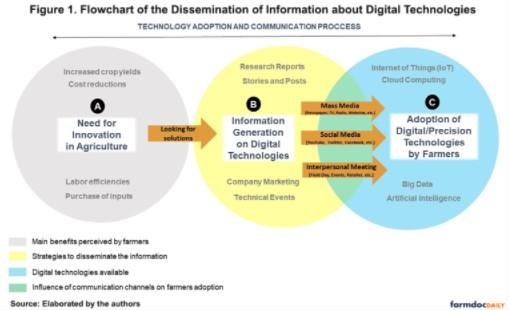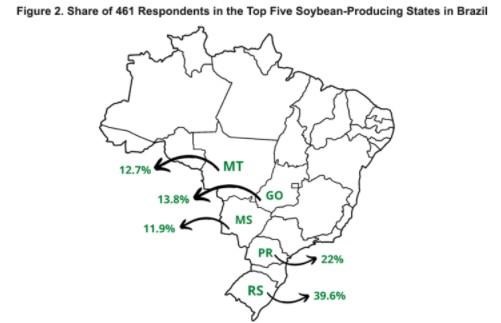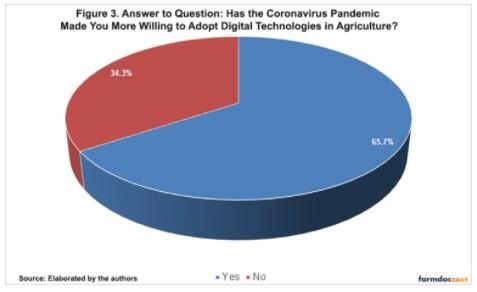By Joana Colussi and Gary Schnitkey
Department of Agricultural and Consumer Economics
University of Illinois
Antônio Domingos Padula
Graduate Program in Management
Federal University of Rio Grande do Sul (Brazil)
How do farmers decide what precision and digital agricultural technologies to adopt? Moreover, how do communication channels affect their decision-making? To answer these questions we are inviting soybean farmers in Illinois, Iowa, Minnesota, Indiana, and Nebraska – the top five soybean-producing states in the United States – to take a short survey (https://go.illinois.edu/farmdocsurvey). We have already collected data from Brazil’s top soybean-producing states. Our objective is to measure the influence of various communication channels on farmers’ decisions in both countries, which are world leaders in soybean production.
The survey takes five to eight minutes to complete, and responses are confidential. Participants who provide an email address will receive the survey results. The results will increase knowledge of the most efficient communication channels for the dissemination of digital agriculture technologies. In addition, the study will support new research in agricultural communication, an area still lacking data in the United States and Brazil.
Digital Agriculture
Throughout the history of modern agriculture, technology adoption has contributed to the development of efficient agricultural food production. In the last decades, several technologies have positively affected yield on a global scale, and, more recently, digital technologies are leading the way. Digital agriculture can be understood as a set of technologies for information and analysis that allows farmers to plan, monitor and manage the operational and strategic activities of production systems.
This digital transformation is one of the most significant developments in recent history. Some studies suggest there has been an informational revolution in the agricultural sector (Dyer 2016). Estimates from the United Nations Global Compact, for example, indicate that the global market for digital agriculture will be $15 billion in 2021. Adoption of digital technologies by farmers has been increasing for a decade. This trend likely will continue at an accelerated pace, given the increased venture capital being devoted to developing these technologies (Boehlje & Langemeier 2021).
The digital transformation has a key role in agribusiness, because it leads to smarter decisions, higher efficiency and easier sharing of knowledge. Based on the premise that diffusion is the process by which an innovation is communicated over time among the participants in a social system (Rogers 2003), this survey concentrates on one of the main elements that influences the spread of a new idea: communication channels. In other words, information is a determinant variable in the process of adopting innovations.
Many empirical and scientific studies have shown that the lack of the ability to use these tools along with the shortage of knowledge about the most appropriate technologies contribute to farmers’ current uneasiness about digital technology adoption (Pope & Sonka 2020; Bolfe et al. 2020). Although there is a consensus that information is essential to the adoption of digital technology, there is no common understanding of which are the most efficient communication channels to influence soybean farmers’ decision-making. Our study will shed light on this specific topic, according to the following multidisciplinary analytical structure.
The Role of Communication
The communication process refers to how people share information in an attempt to achieve mutual understanding (Rogers 2003). There are several ways to disseminate information to farmers about new technologies, such as mass media (newspaper, magazines, radio, television, and websites/blogs), social media (YouTube, Facebook, Pinterest, Instagram, and Twitter) and interpersonal meetings (field days, conferences, retailers, extension agents, peer groups, and conversations with neighbors).
Based on the main elements that influence the diffusion of innovation (Rogers 2003) and the essential determining components of acceptance and use of technology (Venkatesh et al. 2003), this study will propose advancements in relation to the role of communication on the adoption of digital technologies among soybean farmers in Brazil and the United States. To achieve this goal, the project proposes the follow multidisciplinary analytical structure:

The analytical structure stems from the farmers’ needs to look for innovations in agriculture and its benefits, such as increased crop yields, cost reductions, labor efficiencies, and purchase of inputs (ball A). The need for innovation leads the farmer to seek out solutions developed by the market and, consequently, the information generated by research reports, stories and posts, company marketing, and technical events (ball B). This information is distributed through different channels of communication, divided into mass media, social media, and interpersonal meetings – all of which indicate an intersection between balls B and C. Therefore, the consumption of this information helps many farmers to adopt digital/precision technologies that may involve the Internet of Things (IoT), cloud computing, big data, and artificial intelligence (ball C).
Survey Conducted in Brazil
The online survey was available for two months in Brazil, from April 1 to May 31, 2021, and reached 461 respondents. The target was soybean farmers in the top five soybean-producing states in Brazil: Mato Grosso (MT), Paraná (PR), Rio Grande do Sul (RS), Goiás (GO) and Mato Grosso do Sul (MS). These five states represent 75% of soybean production in Brazil. Regionally, 61.6% of survey participants were from the Southern states and 38.4% from Midwestern states.

It is important to highlight that data were collected in Brazil during the worst moment of the COVID-19 pandemic. During this period, many digital tools supported on-farm production, by providing online advice and facilitating access to inputs and machinery services. Could the pandemic thus accelerate a digital revolution in agriculture? The results of the survey carried out in Brazil show that it can. Among the respondents, 65.7% answered that the pandemic made them more willing to adopt digital technologies.

Quantitative data was collected using a questionnaire with 13 questions (multiple choice). The questions approached the use of precision and digital tools and the level of influence of mass media, social media, and interpersonal meetings on the decision to adopt new technologies on the farm. All respondents are asked to answer the same questions, with some adaptations for each country. After completing the data collection in the U.S., it will be possible to compare the data from both countries. The results will show how soybean producers in Brazil and the U.S. consider and adopt new precision and digital agricultural technologies and how communication channels influence their decision-making.
This research is the result of the international partnership between the College of Agricultural, Consumer & Environmental Sciences (ACES) at the University of Illinois at Urbana-Champaign and the Graduate Program in Management at the Federal University of Rio Grande do Sul (UFRGS/Brazil), in Brazil.
Source : illinois.edu